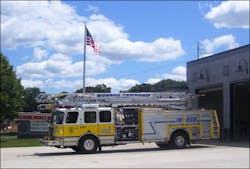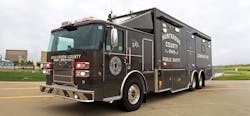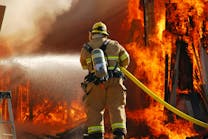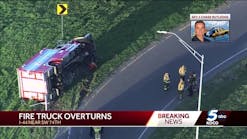A fire department is composed of many functional units, referred to as companies. At the basic level most departments consist of mainly engine and truck companies. Engine companies are responsible for securing water at the fire scene, putting initial handlines in position, protecting exposures, operating master streams, and extinguishing the fire. Truck companies specialize in supportive operations, such as forcible entry, laddering, utility control, ventilation, and search and rescue. There are some departments that provide their firefighters with apparatus and equipment that can accomplish most of these tasks with one unit and they are referred to as quints.
Quint Capabilities
A quint is a motorized fire apparatus that has five features: a permanently mounted fire pump, an on-board water tank, an area for hose storage, an aerial/elevated platform with a permanently affixed waterway, and an ample supply of ground ladders (see Photo 1). These five basic components are what define the quint's capabilities. The quint has also become more user-friendly over the years. There have been great advancements in reach and stability, shorter wheelbases, and higher powered diesel engines have made these units more capable of any task on the fireground that is required. This apparatus can combat structure fires, provide continued elevated egress, and serve as an elevated master stream all within one unit.
In the era of tough economic times, some will argue that having an apparatus that is equipped to handle multiple functions on the fireground is a good thing. This flexibility allows the first arriving units to be adaptable to the needs of the incident, depending on when they arrive. Should they wind up first on the scene, the crew may be required to establish a water supply and stretch a handline in to extinguish the fire. In the event the quint arrives after the first engine, the crew may need to begin the primary search and ventilation of the fire.
Quint Shortfalls
While the deployment of these units definitely have merit, there are operational deficits that must be identified. First and foremost--and this goes for any piece of apparatus--fire apparatus do not put out fires: competent, trained firefighters do. The common misconception that many departments make during the purchase of these units is that the crew is equipped to handle both engine company and ladder company responsibilities on the fireground. To some extent, they are correct; however, the crew can not handle both responsibilities at the same time (see Photo 2). So, for those who think these units staffed with four firefighters can take the place of two four member companies of different competencies, they are in for a surprise: combining companies to run with fewer personnel in inefficient, unsafe, and ultimately means less work on the fireground is getting done. Any type of firefighting apparatus that is "equipped" with less than four firefighters is unsafe and inefficient, no matter what the incident is.
Additionally, all of the upgrades and advancements in apparatus technology come with some limitations. Smaller vehicles come with smaller capabilities, whether it is related to aerial reach, compartmentation, or water tank and hose carrying capabilities. Trying to get all of the equipment necessary to function as two different companies onto the boundaries of one vehicle can be troublesome, requiring departments to make tough decisions on what tools and equipment are more important than other necessities.
The Quint: An Informed Decision
There are many conditions that will weigh heavily on a department's decision to purchase new apparatus. As most departments are facing financial hardship and are being forced to do more with less, the "Quint Concept" seems like an acceptable choice. But, before signing on the dotted line, department leaders are wise to consider these three points:
1. Know your geographic area. It is not enough to know about the borders and response jurisdictions in your town; more importantly, you need to know how the apparatus will arrive and operate on any location in your community. Many apparatus dealers have access to demonstration models that departments can look at prior to deciding on a purchase. It would be wise to take the apparatus for a tour of the potential response areas, and see how it stands up those response needs.
Take the unit to the tallest structures in your area and spot the turntable. The goal of spotting the turntable is to get the turntable into a position that will allow the device to be used most effectively, usually in an area where the turntable is perpendicular to the objective in question. Does it reach all of the areas it needs to? Can it make it around tight areas to the rear of the structure when it needs to? How much total room is needed to set up for elevated operations? Most people that test out a quint for purchase do not take into consideration how much room the unit requires when it is being set up for aerial operations.
Next, take it to the "set back" areas of the community, and see how much aerial capabilities are exhausted just getting from the curb to the upper floor or roof. If the area is known for having large landscapes in front of the residences, what options does the unit have to compensate for reach? Can it make it up the driveway and set up? Are there alternative options for operating from another angle, side or street that can compensate for the set back?
2. Know your options. There are many different apparatus manufacturers that can boast of the capabilities and options of the vehicles that they construct. Even after diligent note taking and research, departments can still find themselves at odds over certain options and vehicle potential that each unit offers. One of the best ways to determine which one offers the most value for the department's dollar is to invite them all to bring their vehicles down to fire headquarters for a side-by-side comparison. Perhaps one manufacturer provides an option that another does not, but can come close to what is important to the department's needs. Members of the department can also compare road handling and driving issues with each vehicle and can make a more educated decision when compared side-by-side.
3. Know your firefighter's capabilities. The investment made in the department staff is the most valuable resource to a community. The combination of both engine and ladder company functions onto one piece of apparatus will require your staff members to take on more responsibilities, which may require more training in these areas. From a training officer's point of view, it would be beneficial to know well in advance that the department was heading in a direction that will combine these duties onto one unit. This would allow the focus for preparation of staff members to be competent and cross-trained in multiple responsibilities prior to when these vehicles arrive in their jurisdiction. This may be a difficult task for larger fire departments; having to provide this cross-training for hundreds of staff members can be a logistical nightmare and a pricey undertaking.
With the increase of capabilities this apparatus provides, the increase of needed manpower is relative to the assignments on the fireground. Should this unit arrive, and have to perform multiple tasks upon arrival (for example: stretch a hoseline through the front door and ladder the upper floors for rescue or ventilation), this would require at a minimum of seven firefighters to effectively and safely operate under this scenario. If this unit will truly be responsible to multi-task at an incident, it will still require an adequate number of competent firefighters on-scene to perform these tasks.
Conclusion
Multiple function fire apparatus is becoming the standard today. As volunteer companies struggle with dwindling membership and career departments are coping with shrinking budgets and higher operational costs. The use of the quint in these departments can be a successful decision, so long as there is a clear understanding of their limitations. These units can indeed function as both an engine company and a ladder company: they just cannot do it at the same time, without the proper amount of competent and trained firefighters to maximize the use of the apparatus and to accomplish the necessary duties on the fireground.
MICHAEL P. DALEY is a lieutenant and training officer with the Monroe Township, NJ, Fire District No. 3, and is an instructor with the Middlesex County Fire Academy, where he is responsible for rescue training curriculum development. Mike has an extensive background in fire service operations and holds degrees in business management and public safety administration. Mike serves as a rescue officer with the New Jersey Urban Search and Rescue Task Force 1 and is a managing member for Fire Service Performance Concepts, a consultant group that provides assistance and support to fire departments with their training programs and course development. Mike was a panelist on Radio@Firehouse on the Successful Rescue Operations in Today's Fire Service. You can reach Michael by e-mail at [email protected].
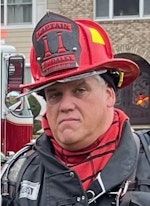
Michael Daley
MICHAEL DALEY, who is a Firehouse contributing editor, is a 37-year veteran who serves as a captain and department training officer in Monroe Township, NJ. He is a staff instructor at multiple New Jersey fire academies and is an adjunct professor in the Fire Science Program at Middlesex County College. Daley is a nationally known instructor who has presented at multiple conferences, including Firehouse Expo and Firehouse World. His education includes accreditations as a Chief Training Officer and a Fire Investigator, and he completed the Craftsman Level of education with Project Kill the Flashover. Daley is a member of the Institution of Fire Engineers and a FEMA Instructor and Rescue Officer with NJ Urban Search and Rescue Task Force 1. He operates Fire Service Performance Concepts, which is a training and research firm that delivers and develops training courses in many fire service competencies.
